
A buffalo or a bison? Honestly, I wasn’t sure myself as I’d heard them both interchangeably, so I had to look it up. The correct answer is this is an American Bison. Buffaloes are found in Africa (Cape Buffalo) and South Asia (Water Buffalo), while bison roam in North and South America. There’s much more to be learned from this Bison story, which you can find below.
Great Falls, MT
As I venture around Montana, Great Falls would be my next stop. This was a quick two night stay, so there was limited time to explore. This city of over 60,000 residents had lots to share, so I had to make do with what time I had available. Named for the 5 waterfalls that exist along the Missouri River, it also boasts 5 hydroelectric dams giving it its other nickname -The Electric City. Once the largest city in Montana from 1950-1970, it was beaten out by Billings in the 1970 census, and in 2000, was relegated to third largest when eclipsed by the now 2nd largest Missoula.
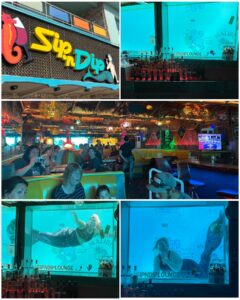 One of the places to visit on my list was actually a bar, so I figured I’d knock that one out on my travel day after I arrived. Seemed like a good place for dinner and a drink. What makes this “Sip N Dip” hotel bar place so special, besides having been named the #1 Bar in the world to fly for by GQ Magazine in 2003, is that it also features a giant full wall view into the hotel’s swimming pool. The bar opened in 1962 when Tiki-style bars were the thing, and it has managed to maintain this look to this day. Initially, the pool view was simply to be bar patron entertainment by hotel guests swimming around. That is until 1995 when the hotel manager convinced one of the house keepers to dawn a mermaid suit and splash around in the pool. It was an instant hit, and as they say, the rest is history. Today there is one of several mermaids that entertain bar guests with their frolicking around in the pool each evening. Definitely not something you see every day!
One of the places to visit on my list was actually a bar, so I figured I’d knock that one out on my travel day after I arrived. Seemed like a good place for dinner and a drink. What makes this “Sip N Dip” hotel bar place so special, besides having been named the #1 Bar in the world to fly for by GQ Magazine in 2003, is that it also features a giant full wall view into the hotel’s swimming pool. The bar opened in 1962 when Tiki-style bars were the thing, and it has managed to maintain this look to this day. Initially, the pool view was simply to be bar patron entertainment by hotel guests swimming around. That is until 1995 when the hotel manager convinced one of the house keepers to dawn a mermaid suit and splash around in the pool. It was an instant hit, and as they say, the rest is history. Today there is one of several mermaids that entertain bar guests with their frolicking around in the pool each evening. Definitely not something you see every day!
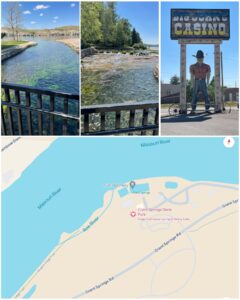 There were several Roadside items to check out in Great Falls. Of course, there would be a Muffler Man somewhere here in town. Sure enough, a cowboy version of him stands tall at Big John’s Casino. This particular Muffler Man lived for 23 years in Jamestown, ND, adorning a motel along I94. He was relocated here to Great Falls around 1999, when he showed up here at the casino. He’s looking pretty good for being close to 50 years old! Next, located in Giant Springs State Park is reportedly the shortest river in the world. Verified by Guinness, this 201 foot Roe River runs along the Missouri River (see at right, bottom). There is a bridge along the center of the river from which you can take pictures of both ends (at right, top). Pretty cool!
There were several Roadside items to check out in Great Falls. Of course, there would be a Muffler Man somewhere here in town. Sure enough, a cowboy version of him stands tall at Big John’s Casino. This particular Muffler Man lived for 23 years in Jamestown, ND, adorning a motel along I94. He was relocated here to Great Falls around 1999, when he showed up here at the casino. He’s looking pretty good for being close to 50 years old! Next, located in Giant Springs State Park is reportedly the shortest river in the world. Verified by Guinness, this 201 foot Roe River runs along the Missouri River (see at right, bottom). There is a bridge along the center of the river from which you can take pictures of both ends (at right, top). Pretty cool!
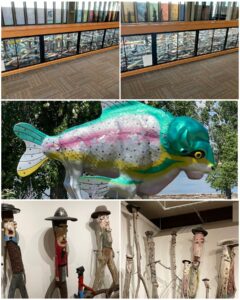 Also in Great Falls at the local airport is a display of what is said to be the largest and most complete collection of commercial model aircraft in existence (at left, top). Gary Poletto began collecting in 1977, and by 2003, had amassed 782 models representing 491 airlines of 128 nations, with varieties and versions from 47 different manufacturers. Supposedly, only two thirds of the collection is actually on display due to space constraints. Fortunately, this is a somewhat small regional airport and I was able to park right outside in the hourly lot, at $1.00 for 30 minutes. Plenty of time to run in and check out this cool collection. Next up is this crazy creature (at left, center) named Rainboffalo – sort of a mutant half fish half buffalo (bison?) that sits along the shores of the Missouri River. It was created in 2005 by artist Chris Miller, and donated to the city of Great Falls in 2010. Last up was a visit to Paris Gibson Square Museum of Art to check out Lee Steen’s Tree People. Self-taught artists Lee worked for 30 years and filled his yard with these human-like characters created from cottonwood branches. He passed away in 1975, and his collection is now part of a permanent display here at the art museum. They were really cool!
Also in Great Falls at the local airport is a display of what is said to be the largest and most complete collection of commercial model aircraft in existence (at left, top). Gary Poletto began collecting in 1977, and by 2003, had amassed 782 models representing 491 airlines of 128 nations, with varieties and versions from 47 different manufacturers. Supposedly, only two thirds of the collection is actually on display due to space constraints. Fortunately, this is a somewhat small regional airport and I was able to park right outside in the hourly lot, at $1.00 for 30 minutes. Plenty of time to run in and check out this cool collection. Next up is this crazy creature (at left, center) named Rainboffalo – sort of a mutant half fish half buffalo (bison?) that sits along the shores of the Missouri River. It was created in 2005 by artist Chris Miller, and donated to the city of Great Falls in 2010. Last up was a visit to Paris Gibson Square Museum of Art to check out Lee Steen’s Tree People. Self-taught artists Lee worked for 30 years and filled his yard with these human-like characters created from cottonwood branches. He passed away in 1975, and his collection is now part of a permanent display here at the art museum. They were really cool!
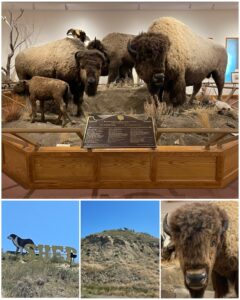 Next, I took a drive about 40 miles to the north east to the town of Fort Benton. There I would find a Roadside item perfectly suited to my sister-in-law Debbie who loves a good dog story. So here, high upon the hillside looking over Fort Benton are the remains and a memorial for a dog named Old Shep – the town’s forever faithful sheep dog (at right, bottom left and center). In 1936, a sheep herder fell ill and, along with his dog Shep, came to Fort Benton for treatment. He passed away a few days later, and was crated to be sent back east to his relatives. Shep followed the crate to the train depot and watched as it was put on board and taken away. Shep apparently followed the train down the tracks for a while, but later returned to the depot. For the next five and a half years, Shep maintained a vigil at the train station, waiting for his master to return. Two and a half years into his watch, Shep was featured in Ripley’s Believe It or Not, and became quite the sensation. Fan mail and Christmas gifts poured in, and travelers even took long detours to stop through Fort Benton just to meet and greet this devoted dog. Tragically, on Jan 12 1942, this now old, arthritic and deaf dog failed to hear the approaching train, slipped on an icy rail, and was sadly struck and killed. Dateline NBC did a story about Shep back in May 2016 which you can watch HERE. This story is such a clear reminder of the devotion given by these best of companion animals.
Next, I took a drive about 40 miles to the north east to the town of Fort Benton. There I would find a Roadside item perfectly suited to my sister-in-law Debbie who loves a good dog story. So here, high upon the hillside looking over Fort Benton are the remains and a memorial for a dog named Old Shep – the town’s forever faithful sheep dog (at right, bottom left and center). In 1936, a sheep herder fell ill and, along with his dog Shep, came to Fort Benton for treatment. He passed away a few days later, and was crated to be sent back east to his relatives. Shep followed the crate to the train depot and watched as it was put on board and taken away. Shep apparently followed the train down the tracks for a while, but later returned to the depot. For the next five and a half years, Shep maintained a vigil at the train station, waiting for his master to return. Two and a half years into his watch, Shep was featured in Ripley’s Believe It or Not, and became quite the sensation. Fan mail and Christmas gifts poured in, and travelers even took long detours to stop through Fort Benton just to meet and greet this devoted dog. Tragically, on Jan 12 1942, this now old, arthritic and deaf dog failed to hear the approaching train, slipped on an icy rail, and was sadly struck and killed. Dateline NBC did a story about Shep back in May 2016 which you can watch HERE. This story is such a clear reminder of the devotion given by these best of companion animals.
Next in Fort Benton I visited the Museum of the Northern Great Plains, to see these really cool, and very historical bison (not buffalo). This collection of six plains bison (at right, top), taken from among the last remaining wild bison between the Missouri and Yellowstone Rivers, is considered to be the most significant collection of these magnificent animals in the world. They were collected in 1886 by zoologist, conservationist and taxidermist William Temple Hornaday. The American Bison were hunted extensively, and were feared to become extinct. Hornaday was tasked with collecting specimens from the region for the United States National Museum collections, so that future generations would know what the buffalo looked like, after their expected extinction. He put together this collection of six animals, which were on display at the Smithsonian Institution in Washington, DC from 1888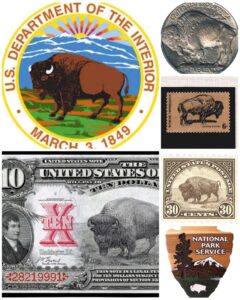 until 1957. It was this display and Hornaday’s conservation work that helped spur outrage at the impending loss, and is widely regarded as the catalyst to having saved the bison from complete extermination. In fact, the Boy Scouts of America’s Conservation Award was named in his honor.
until 1957. It was this display and Hornaday’s conservation work that helped spur outrage at the impending loss, and is widely regarded as the catalyst to having saved the bison from complete extermination. In fact, the Boy Scouts of America’s Conservation Award was named in his honor.
But what also makes this collection of bison, specifically the big boy bull in the display (featured at the top of this blog), is that this particular bison inspired the Great Seal of the Department of Interior, the National Park Service badge, the buffalo nickel, the 1901 $10 bill, and the 1931 30 cent and 1970 6 cent stamps (all shown at left) to all feature a bison modeled after him. After their time at the Smithsonian, this display was shipped to the University of Montana, where they apparently sat in a store room deteriorating and being neglected. Residents of Fort Benton raised $400,000 to have the bison restored and returned to their hometown, and are now proudly on display in their museum. So now you know the rest of this bison story.
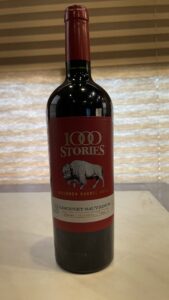 Epilog: During the evening after writing about the Hornaday bison collection, I randomly reached into my cardboard case of mixed bottles of wine to grab a fresh one for a nighttime glass, and managed to pull out this particular bottle. This California bourbon barrel aged Cabernet Sauvignon variety from 1000 Stories just so happened to have a bison on its label. How crazy is that? I looked into it and turns out the 1000 Stories winery has partnered with the organization Yellowstone Forever to support bison conservation at Yellowstone National Park and in doing so, has added this bison to the label on all their wines. Given that conservation association, it’s very likely that their bottle bison was too modeled from the Smithsonian collection’s big boy bull. Hornaday would be so proud!
Epilog: During the evening after writing about the Hornaday bison collection, I randomly reached into my cardboard case of mixed bottles of wine to grab a fresh one for a nighttime glass, and managed to pull out this particular bottle. This California bourbon barrel aged Cabernet Sauvignon variety from 1000 Stories just so happened to have a bison on its label. How crazy is that? I looked into it and turns out the 1000 Stories winery has partnered with the organization Yellowstone Forever to support bison conservation at Yellowstone National Park and in doing so, has added this bison to the label on all their wines. Given that conservation association, it’s very likely that their bottle bison was too modeled from the Smithsonian collection’s big boy bull. Hornaday would be so proud!
Browning, MT
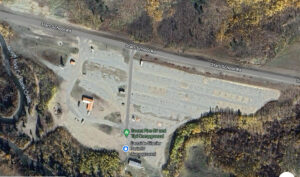 Well, but for the fact that this stop afforded nearby centralized access into Glacier National Park, this was probably my worst stay of my trip so far (maybe ever). First, the campground is new and still under construction and was nothing but a large isolated field of dirt and stones (see aerial view at left), in a valley surrounded by mountains and 15 miles from any civilization. It has also now earned the top honor as being the most expensive nightly rate ever paid at $111 per night, or $665 for a 6 night stay (you know what they say, Location, Location, Location!). Second, there was little to no cell service from either ATT, Verizon, or T-Mobile. The campground did have a couple of shared Starlink setups available, but they were too far away and generally overcrowded to be of any use. With my cell booster that I’ve only used once before in my six plus years of travel, I managed to eke out just enough ATT signal to occasionally get me online. It was a long 6 night stay! And third, the nearby town of Browning, headquarters for the Blackfeet Indian Reservation and whose 1,000 residents are almost exclusively Native American, has to be the most depressed, run down, sketchy, and overall disaster of a town I’ve ever seen. According to Wiki, Browning is a former town and current unincorporated community since it disincorporated on September 26, 2018, after the town’s government collapsed financially. I did go into Browning on a couple of occasions to hit the grocery store, to catch a Roadside America entry, and to fuel up before I left for my next stop. On each occasions, I couldn’t wait to get back to the RV. I definitely didn’t do my due diligence when planning this stop!
Well, but for the fact that this stop afforded nearby centralized access into Glacier National Park, this was probably my worst stay of my trip so far (maybe ever). First, the campground is new and still under construction and was nothing but a large isolated field of dirt and stones (see aerial view at left), in a valley surrounded by mountains and 15 miles from any civilization. It has also now earned the top honor as being the most expensive nightly rate ever paid at $111 per night, or $665 for a 6 night stay (you know what they say, Location, Location, Location!). Second, there was little to no cell service from either ATT, Verizon, or T-Mobile. The campground did have a couple of shared Starlink setups available, but they were too far away and generally overcrowded to be of any use. With my cell booster that I’ve only used once before in my six plus years of travel, I managed to eke out just enough ATT signal to occasionally get me online. It was a long 6 night stay! And third, the nearby town of Browning, headquarters for the Blackfeet Indian Reservation and whose 1,000 residents are almost exclusively Native American, has to be the most depressed, run down, sketchy, and overall disaster of a town I’ve ever seen. According to Wiki, Browning is a former town and current unincorporated community since it disincorporated on September 26, 2018, after the town’s government collapsed financially. I did go into Browning on a couple of occasions to hit the grocery store, to catch a Roadside America entry, and to fuel up before I left for my next stop. On each occasions, I couldn’t wait to get back to the RV. I definitely didn’t do my due diligence when planning this stop!
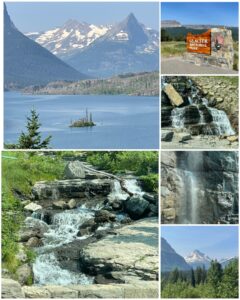 On the plus side, Glacier National Park was amazing! With its beautiful mountain lakes, many waterfalls, and majestic mostly snow covered mountain peaks, it certainly offered some of the most breathtaking views ever. The park is made up of more than one million acres, includes portions of two mountain ranges, over 130 lakes, hundreds of species of animals, and over one thousand varying plants. It is often referred to as the “Crown of the Continent Ecosystem”. It was established as a National Park on May 11, 1910 by President William Howard Taft – making it the 7th park in the system. As visitors increased, and automobiles became more prevalent, work began on the 53-mile long “Going to the Sun Road (GTTSR)”, which was completed in 1932. This road, now a National Historic Civil Engineering Landmark, goes deep into the park, crossing the Continental Divide at over 6,600 feet of elevation at its midpoint. On my first day in the park, I entered from St Mary and hopped on the GTTSR, and all of the pictures at right and left were taken along that route. It was really beautiful. However, as it got further in, and started
On the plus side, Glacier National Park was amazing! With its beautiful mountain lakes, many waterfalls, and majestic mostly snow covered mountain peaks, it certainly offered some of the most breathtaking views ever. The park is made up of more than one million acres, includes portions of two mountain ranges, over 130 lakes, hundreds of species of animals, and over one thousand varying plants. It is often referred to as the “Crown of the Continent Ecosystem”. It was established as a National Park on May 11, 1910 by President William Howard Taft – making it the 7th park in the system. As visitors increased, and automobiles became more prevalent, work began on the 53-mile long “Going to the Sun Road (GTTSR)”, which was completed in 1932. This road, now a National Historic Civil Engineering Landmark, goes deep into the park, crossing the Continental Divide at over 6,600 feet of elevation at its midpoint. On my first day in the park, I entered from St Mary and hopped on the GTTSR, and all of the pictures at right and left were taken along that route. It was really beautiful. However, as it got further in, and started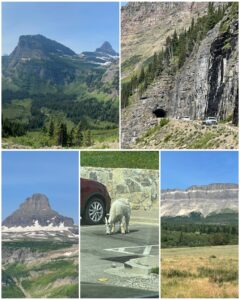 crossing high within the mountains, the roads became more narrow and windy, with sheer cliffs on one side and jagged mountainous rock on the other, making it not ideally suited for my big boy truck. So, I did not make the full run of the road, but rather chickened out just over halfway through. I’d much prefer doing this road with my little Prius!
crossing high within the mountains, the roads became more narrow and windy, with sheer cliffs on one side and jagged mountainous rock on the other, making it not ideally suited for my big boy truck. So, I did not make the full run of the road, but rather chickened out just over halfway through. I’d much prefer doing this road with my little Prius!
On my second day into the park, I drove south and entered in through the entrance known as Two Medicine. This too proved to be quite the challenging drive as the GPS took me by way of Montana Rt 49 coming from the north to get there, and this road had signs restricting total vehicle/tow length to 22 feet (as a point of reference, my truck is 21.9 feet long!). That should have been my first clue! The road was narrower than any two-lane road should be. The turns are sharp and often blind. There’s no guardrail and zero shoulder. I honestly think if I actually had the opportunity to turn around, I very likely would have! But alas, once you are on it, you are on it and there’s no going back. So I manned up and on I went, white knuckled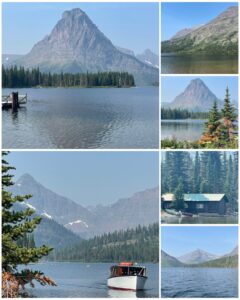 all the way, and eventually arrived at Two Medicine in one piece – albeit just a bit worn and weary. I definitely took a different route back which was way more driver friendly. In the end however, I’m sure glad I visited this part of the park. It was truly exceptional! This part is often less visited than other parts of Glacier, but is sure impressive with its dramatic views and reflective lake. There was even the opportunity to take a boat tour on the 98 year old wooden boat named Sinopah. While I’m not really a boat fan, it was a calm lake so I figured it should be a sea-sick and puke-free adventure. And sure enough it was. It was a delightful trip around the lake, while the captain offered up history and trivia about this mountainous area and its early inhabitants. I’m sure glad I made the trip to visit this part of Glacier – though next time, I’ll take the long route to get there!
all the way, and eventually arrived at Two Medicine in one piece – albeit just a bit worn and weary. I definitely took a different route back which was way more driver friendly. In the end however, I’m sure glad I visited this part of the park. It was truly exceptional! This part is often less visited than other parts of Glacier, but is sure impressive with its dramatic views and reflective lake. There was even the opportunity to take a boat tour on the 98 year old wooden boat named Sinopah. While I’m not really a boat fan, it was a calm lake so I figured it should be a sea-sick and puke-free adventure. And sure enough it was. It was a delightful trip around the lake, while the captain offered up history and trivia about this mountainous area and its early inhabitants. I’m sure glad I made the trip to visit this part of Glacier – though next time, I’ll take the long route to get there!
Once again, I’ve combined the photos and video taken with my phone camera, along with the video captured by the dash cam in the truck, and whipped up this little video montage of my trip through Glacier National Park. I hope you enjoy it!
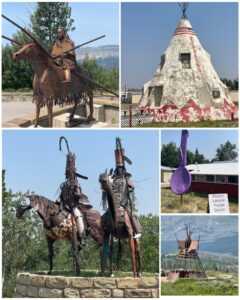 Being that this area is heavily influenced by Native American heritage, it was no surprise that many of the Roadside items would be reflective of that culture. Take for example, this giant concrete teepee (at left, top right). It once served as a really cool coffee shop, but much like everything else in town, it has fallen on hard times. Long since abandoned as a business and definitely showing signs of decay, it’s yet just another sad reminder of the state of affairs in downtown Browning. Next is this Native American on horseback metal sculpture, and teepee sculpture along highway 89 known as the Blackfoot Memorial. In 2023, just a couple of years following the death of Blackfeet Chief Earl Old Person at the age of 92, a section of Rt 89 was named after him in his honor. Further south on Rt 2 in East Glacier stands this pair of scrap metal sculptures (at left, bottom left) representing two Blackfeet warriors that serve to mark the entrance to the Blackfoot Nation. Last up in East Glacier is this 25 foot giant purple wooden spoon – purporting to be the world’s largest purple wooden spoon, that sits outside of a store that sells hand-crafted cooking wooden spoons. I guess if you get that specific, including color and all, I suppose it could be valid record.
Being that this area is heavily influenced by Native American heritage, it was no surprise that many of the Roadside items would be reflective of that culture. Take for example, this giant concrete teepee (at left, top right). It once served as a really cool coffee shop, but much like everything else in town, it has fallen on hard times. Long since abandoned as a business and definitely showing signs of decay, it’s yet just another sad reminder of the state of affairs in downtown Browning. Next is this Native American on horseback metal sculpture, and teepee sculpture along highway 89 known as the Blackfoot Memorial. In 2023, just a couple of years following the death of Blackfeet Chief Earl Old Person at the age of 92, a section of Rt 89 was named after him in his honor. Further south on Rt 2 in East Glacier stands this pair of scrap metal sculptures (at left, bottom left) representing two Blackfeet warriors that serve to mark the entrance to the Blackfoot Nation. Last up in East Glacier is this 25 foot giant purple wooden spoon – purporting to be the world’s largest purple wooden spoon, that sits outside of a store that sells hand-crafted cooking wooden spoons. I guess if you get that specific, including color and all, I suppose it could be valid record.
Polson, MT
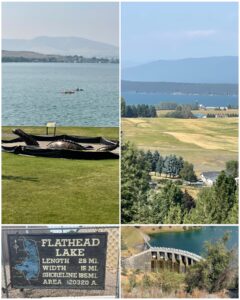 Wow, what a difference a day and roughly 150 miles can make! As I cheered during my departure from Browning, hoping for better times ahead, I pulled into the delightful KOA campground in Polson, MT. This gorgeous lakeside town of just over 5,000 residents, sits on the southern shores of beautiful Flathead Lake. This lake has the distinction of being the largest natural body of freshwater in the western US, and is also one of the cleanest lakes in the world. At 28 miles tall and 15 miles wide, it offers 185 miles of breathtaking shoreline along the borders of its 126,000 acre surface area. Beautiful resort-style towns have sprung up all along its shoreline, as well as lots of cherrie orchard farms. Montana Flathead cherries are renowned for their sweetness, having been grown in the ideal climate provided in this area. At the southern end of the Flathead River is the Kerr Dam (at right, bottom right) – a hydroelectric gravity-arch dam. It was built between 1930 to 1938, and features 3 turbines producing over 1,000 GWh of power annually. Besides raising the Flathead Lake which mostly serves as a recreational area, the dam also manages area irrigational needs as well. It really is an absolutely beautiful and very clean lake! One of the Roadside items I checked out was new, in fact so new it was just
Wow, what a difference a day and roughly 150 miles can make! As I cheered during my departure from Browning, hoping for better times ahead, I pulled into the delightful KOA campground in Polson, MT. This gorgeous lakeside town of just over 5,000 residents, sits on the southern shores of beautiful Flathead Lake. This lake has the distinction of being the largest natural body of freshwater in the western US, and is also one of the cleanest lakes in the world. At 28 miles tall and 15 miles wide, it offers 185 miles of breathtaking shoreline along the borders of its 126,000 acre surface area. Beautiful resort-style towns have sprung up all along its shoreline, as well as lots of cherrie orchard farms. Montana Flathead cherries are renowned for their sweetness, having been grown in the ideal climate provided in this area. At the southern end of the Flathead River is the Kerr Dam (at right, bottom right) – a hydroelectric gravity-arch dam. It was built between 1930 to 1938, and features 3 turbines producing over 1,000 GWh of power annually. Besides raising the Flathead Lake which mostly serves as a recreational area, the dam also manages area irrigational needs as well. It really is an absolutely beautiful and very clean lake! One of the Roadside items I checked out was new, in fact so new it was just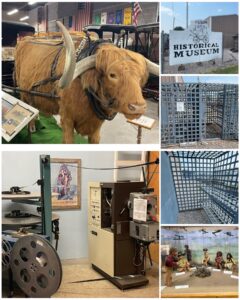 unveiled a few weeks before my arrival, and is still being finished. It’s a giant 25 foot serpent type creature (at right, top left) poking in and out of the ground near the shore of the lake in a downtown community park. Very nice indeed!
unveiled a few weeks before my arrival, and is still being finished. It’s a giant 25 foot serpent type creature (at right, top left) poking in and out of the ground near the shore of the lake in a downtown community park. Very nice indeed!
I also checked out the local Polson Historical Museum which was pretty cool. It featured the stuffed remains of a famous local Highland Steer named Rudolph who appeared in many parades throughout the years in northwest Montana, Canada, Washington, and Oregon. It also had displays from the early 1900s of the boat regatta that was held annually, as well as lots of local artifacts from life in the early pioneer days. What I found particularly interesting was a platter-based movie projection system, similar to one that I used to operate back in my projectionist days working in a movie theater. Ah, the memories! Out back was an early century jail cell – having very limited accommodations, that slept two people. Times were sure rough for the bad guys back then!
Garrison, MT
As I continue my southerly trek through Montana, my next stop takes me to Garrison. This sparsely populated area of 115 residents is not even called a town – but rather a census-designated place (CDP). I’m not sure exactly what that is, but I believe it translates to very rural and small. Fortunately, the campground I booked was equally sparse yet amazingly accomodating, with only about 50 sites, many having nicely distanced and amazingly long 120 foot full hook up pull thrus, with panoramic views of mountain ranges on multiple sides. And, my T-Mobile device was offering blazing fast Internet speeds. What more could I ask for! As you might imagine, Garrison didn’t have anything of interest to see, but a couple of the nearby towns had some interesting places to check out.
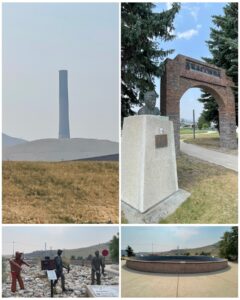 First up, I drove about 35 miles to the south to the town known as Anaconda. In its heyday back in the 1930s to 1960s, it had a bustling population around 12,000. Today, it just over 9,000. Butte, MT is located just 24 miles to the west, and was the source of the industry that put Anaconda on the map. If you recall from my visit to Butte, it is best known as a copper mining town. That copper ore was shipped here to Anaconda by rail, where it was processed and refined (smelted) in what would become the world’s largest non-ferrous processing plant. That refining complex was shutdown in 1980, and all of its infrastructure has since been torn down. That is, all except this amazing smokestack (at right, top left). When it was scheduled to be destroyed, a local preservation group sprung up and managed to keep the smokestack standing. Good thing as it is actually the tallest masonry structure in the world at an amazing 585 feet! Today, an interpretive park has been created with lots of history about the complex, and even a representation of the top (at right, bottom right) and bottom diameter of the smokestack structure – at 60 and 91 feet respectively. Also in downtown Anaconda is Kennedy Park – named after JFK. In fact, they commissioned a local artist to create a bust of JFK to place in the park. Roadside notes this attraction to be a “slightly disheveled, bust of JFK with blank eyes, a misshapen head, a loosened necktie, and a rumpled suit jacket”. Yea, certainly not his best look!
First up, I drove about 35 miles to the south to the town known as Anaconda. In its heyday back in the 1930s to 1960s, it had a bustling population around 12,000. Today, it just over 9,000. Butte, MT is located just 24 miles to the west, and was the source of the industry that put Anaconda on the map. If you recall from my visit to Butte, it is best known as a copper mining town. That copper ore was shipped here to Anaconda by rail, where it was processed and refined (smelted) in what would become the world’s largest non-ferrous processing plant. That refining complex was shutdown in 1980, and all of its infrastructure has since been torn down. That is, all except this amazing smokestack (at right, top left). When it was scheduled to be destroyed, a local preservation group sprung up and managed to keep the smokestack standing. Good thing as it is actually the tallest masonry structure in the world at an amazing 585 feet! Today, an interpretive park has been created with lots of history about the complex, and even a representation of the top (at right, bottom right) and bottom diameter of the smokestack structure – at 60 and 91 feet respectively. Also in downtown Anaconda is Kennedy Park – named after JFK. In fact, they commissioned a local artist to create a bust of JFK to place in the park. Roadside notes this attraction to be a “slightly disheveled, bust of JFK with blank eyes, a misshapen head, a loosened necktie, and a rumpled suit jacket”. Yea, certainly not his best look!
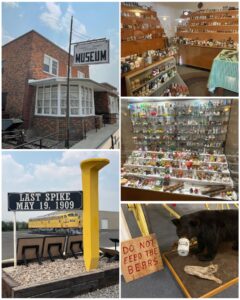 Next, I visited the town of Deer Lodge which had several Roadside places to check out. First up was a visit to the Powell County Museum. There, I would find an exhibit of a massive collection of salt and pepper shakers. Belonging to Ron and Donna Weber, this display features hundreds of pairs of shakers, representing all sorts of different genres. Pretty cool collection! Also on display at this museum is this interesting bear with a can stuck on its nose, with a sign reading Do Not Feed the Bears. Too funny! Across the street from the museum is this giant 11-foot tall golden spike. It was originally some 2.5 miles east where it marked the spot to celebrate the “wedding of the rails” linking the railways between Chicago, IL and Tacoma, WA on May 19, 1909. The spike stood there until 1981, and was then moved to the nearest town, Deer Lodge, where it was stored in the highway maintenance building for over 20 years. In 2003, it was resurrected, restored, and placed here on Main Street in dowtown. Interestingly, the wooden spike significantly outlasted the railroad that it was built to celebrate, which went out of business in 1985.
Next, I visited the town of Deer Lodge which had several Roadside places to check out. First up was a visit to the Powell County Museum. There, I would find an exhibit of a massive collection of salt and pepper shakers. Belonging to Ron and Donna Weber, this display features hundreds of pairs of shakers, representing all sorts of different genres. Pretty cool collection! Also on display at this museum is this interesting bear with a can stuck on its nose, with a sign reading Do Not Feed the Bears. Too funny! Across the street from the museum is this giant 11-foot tall golden spike. It was originally some 2.5 miles east where it marked the spot to celebrate the “wedding of the rails” linking the railways between Chicago, IL and Tacoma, WA on May 19, 1909. The spike stood there until 1981, and was then moved to the nearest town, Deer Lodge, where it was stored in the highway maintenance building for over 20 years. In 2003, it was resurrected, restored, and placed here on Main Street in dowtown. Interestingly, the wooden spike significantly outlasted the railroad that it was built to celebrate, which went out of business in 1985.
 The next stop in this itinerary was a visit to the Old Montana Prison & Auto Museum. Kind of an interesting combination, but I guess it works. In an attempt to tame the outlaws and vigilantes of the Wild West, a prison was built here in Deer Lodge in 1871. It was constructed primarily with convict labor, and the Old Montana Prison was in active use until 1979, when it was moved to a new site four miles west of town. Much of the original 1800s structures are gone – lost to an earthquake in 1959 and torn down. The original 1896 cell house housed 32 youth and 258 men – thoug did not have running water or sewer. Rather, each cell had two buckets – one for sewage and the other for water. The 1912 cell house (at right, center left) was a model facility in its day with each cell having running water, flush toilets, and good ventilation. This complex featured eight galleries (at right, bottom right) each having 200 individual cells (at right, center right).
The next stop in this itinerary was a visit to the Old Montana Prison & Auto Museum. Kind of an interesting combination, but I guess it works. In an attempt to tame the outlaws and vigilantes of the Wild West, a prison was built here in Deer Lodge in 1871. It was constructed primarily with convict labor, and the Old Montana Prison was in active use until 1979, when it was moved to a new site four miles west of town. Much of the original 1800s structures are gone – lost to an earthquake in 1959 and torn down. The original 1896 cell house housed 32 youth and 258 men – thoug did not have running water or sewer. Rather, each cell had two buckets – one for sewage and the other for water. The 1912 cell house (at right, center left) was a model facility in its day with each cell having running water, flush toilets, and good ventilation. This complex featured eight galleries (at right, bottom right) each having 200 individual cells (at right, center right).
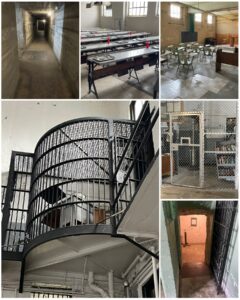 The complex also featured the dining hall, chapel, library, and education rooms. It also had haunting looking underground tunnels that were used to shuffle inmates from the various cell areas to the common areas. Numerous isolation cells were located in the basement, with sparse accommodations, no natural lights, and thick sound breaking walls and doors. Personally, a visit to this place back in the day would certainly have kept me on the straight and narrow!
The complex also featured the dining hall, chapel, library, and education rooms. It also had haunting looking underground tunnels that were used to shuffle inmates from the various cell areas to the common areas. Numerous isolation cells were located in the basement, with sparse accommodations, no natural lights, and thick sound breaking walls and doors. Personally, a visit to this place back in the day would certainly have kept me on the straight and narrow!
So, along with the prison museum, you sort of get a “two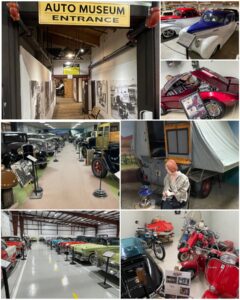 fer” as the admission price includes a visit to the attached car museum. So, I’ve been to a lot of car museums in my travels, and I must admit, my expectations for this small town museum were set kinda low. Boy, was I mistaken! This car museum was absolutely fantastic! At each turn, you entered into yet another room, filled with all sorts of beautifully restored classic cars, one room after the next. In fact, it was listed by USA Today as one of the Top 10 Car Museums in the country. Who knew! It was much larger than I had anticipated, and included lots and lots of truly classic hot rods – over 200 as noted on their website. Far too many to outline here, but suffice to say, it was definitely impressive! For my own personal enjoyment, they even had 1933 Kozy Kamp Pop-Up Trailer (at right, center right) showing what early life RVing was all about (no thanks). You can see many of the more interesting vehicles that were there in the museum if you check out all the pictures I took and posted via the Flickr Photo link at the bottom of this blog.
fer” as the admission price includes a visit to the attached car museum. So, I’ve been to a lot of car museums in my travels, and I must admit, my expectations for this small town museum were set kinda low. Boy, was I mistaken! This car museum was absolutely fantastic! At each turn, you entered into yet another room, filled with all sorts of beautifully restored classic cars, one room after the next. In fact, it was listed by USA Today as one of the Top 10 Car Museums in the country. Who knew! It was much larger than I had anticipated, and included lots and lots of truly classic hot rods – over 200 as noted on their website. Far too many to outline here, but suffice to say, it was definitely impressive! For my own personal enjoyment, they even had 1933 Kozy Kamp Pop-Up Trailer (at right, center right) showing what early life RVing was all about (no thanks). You can see many of the more interesting vehicles that were there in the museum if you check out all the pictures I took and posted via the Flickr Photo link at the bottom of this blog.
Dillon, MT
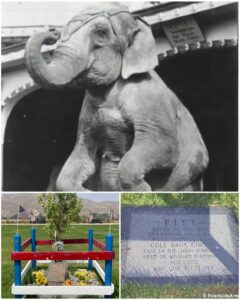 My final stop along the exploration across Montana takes me to Dillon. A nice little town with a population just over 3,800, is predominately known for its railroad. With its proximity centered around several gold mining towns in the area, it was ideally suited to serve as a hub of transport for people and goods to these nearby towns. The biggest attraction here in town was the gravesite of Old Pitt. A circus elephant that was part of a traveling show that was in Dillon to perform at the Beaverhead County Fairgrounds. It was a stormy day on Aug 6th, 1943, and poor Old Pitt was struck by lightning and was killed just as he was about to enter the tent to perform. He was buried on the spot of his demise, and this memorial marks the event. Old Pitt was 50 at the time of his death, and had a long career as a circus star. A service was held on Aug 6, 2023, honoring the 80th anniversary of his death. A Montana NBC affiliate covered that event, and did an interesting story about Pitt’s life. You can view that story HERE.
My final stop along the exploration across Montana takes me to Dillon. A nice little town with a population just over 3,800, is predominately known for its railroad. With its proximity centered around several gold mining towns in the area, it was ideally suited to serve as a hub of transport for people and goods to these nearby towns. The biggest attraction here in town was the gravesite of Old Pitt. A circus elephant that was part of a traveling show that was in Dillon to perform at the Beaverhead County Fairgrounds. It was a stormy day on Aug 6th, 1943, and poor Old Pitt was struck by lightning and was killed just as he was about to enter the tent to perform. He was buried on the spot of his demise, and this memorial marks the event. Old Pitt was 50 at the time of his death, and had a long career as a circus star. A service was held on Aug 6, 2023, honoring the 80th anniversary of his death. A Montana NBC affiliate covered that event, and did an interesting story about Pitt’s life. You can view that story HERE.
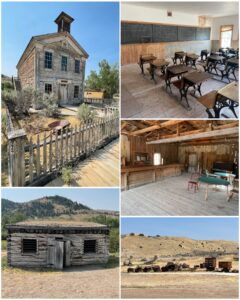 Speaking of nearby gold mining towns, I next headed about 25 miles west of Dillon to visit the town of Bannack. this once booming mining town is now a ghost town and a state park. It was July of 1862 when a couple of prospectors from Colorado discovered gold in the nearby creek. They camped and continued prospecting, finding good gold in the area. They then filed one of the first mining claims in what would eventually become the state of Montana. News travelled fast and this camping town became known as Bannack – growing from about 400 that fall, swelling to over 3,000 by the springtime. Many buildings for housing and support services evolved quickly. A post office, courthouse, saloon, school, drug store, church, and even a luxury hotel are all on the property. A wooden sidewalk that runs along both sides makes for an easy walk to visit many of the sites. There are thirty or so buildings, many with extensive water damage and in disrepair (not surprising for many being over 140 years old), but all original from back in the day. It was a fun afternoon touring this once bustling town.
Speaking of nearby gold mining towns, I next headed about 25 miles west of Dillon to visit the town of Bannack. this once booming mining town is now a ghost town and a state park. It was July of 1862 when a couple of prospectors from Colorado discovered gold in the nearby creek. They camped and continued prospecting, finding good gold in the area. They then filed one of the first mining claims in what would eventually become the state of Montana. News travelled fast and this camping town became known as Bannack – growing from about 400 that fall, swelling to over 3,000 by the springtime. Many buildings for housing and support services evolved quickly. A post office, courthouse, saloon, school, drug store, church, and even a luxury hotel are all on the property. A wooden sidewalk that runs along both sides makes for an easy walk to visit many of the sites. There are thirty or so buildings, many with extensive water damage and in disrepair (not surprising for many being over 140 years old), but all original from back in the day. It was a fun afternoon touring this once bustling town.
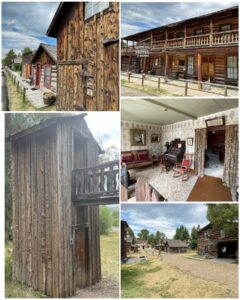 To the east about 60 miles are a couple more former gold towns. In 1863, gold was discovered in Alder Creek, and the boomtown of Virginia City was born. Thousands of prospectors and fortune seekers arrived within weeks of the discovery. Now a designated National Historic Landmark District, modern houses have evolved around the area brining the town’s population to just over 200. Then a couple of miles down the road is yet another old mining town known as Nevada City. This sister city to Virginia City, these two gold rush mining towns combined were known to represent one of the richest gold strikes in the Rocky Mountain West. Once again, a number of original historic buildings are there for the viewing, including a blacksmith shop, hotel, and what was once a doctors home and office. Behind the hotel was the original double decker outhouse still standing (at left, bottom left). I sure would not want to be the one in the bottom stall when someone was up using the top stall!
To the east about 60 miles are a couple more former gold towns. In 1863, gold was discovered in Alder Creek, and the boomtown of Virginia City was born. Thousands of prospectors and fortune seekers arrived within weeks of the discovery. Now a designated National Historic Landmark District, modern houses have evolved around the area brining the town’s population to just over 200. Then a couple of miles down the road is yet another old mining town known as Nevada City. This sister city to Virginia City, these two gold rush mining towns combined were known to represent one of the richest gold strikes in the Rocky Mountain West. Once again, a number of original historic buildings are there for the viewing, including a blacksmith shop, hotel, and what was once a doctors home and office. Behind the hotel was the original double decker outhouse still standing (at left, bottom left). I sure would not want to be the one in the bottom stall when someone was up using the top stall!
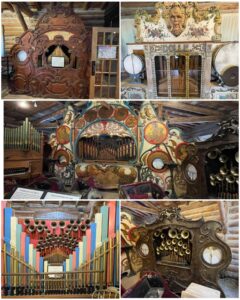 Along with the historic town visit, the admission also included a tour through what is reported to be one of the largest selection of player piano and automated music machines in North America. The Nevada City Music Hall has an amazing collection of music devices from well known makers such as Regina, Wurlitzer, Violi, and Hammond, as well as Gavioli organs, made in Paris in the 1890’s. Many of these old and historic music boxes had been restored and are fully operational. A young boy happened to be wandering around this part of the museum while I was there, and had a pocket full of quarters to get each of the machines to sing. So, I wandered around behind him and enjoyed the music while watching him dance as he brought each machine to life. This collection also boasts having the biggest music organ in the world (at right, center). Built in Paris, France, about 1880, this Gavioli military band organ is 27 feet wide, 12 feet high and four feet deep. It was amazing!
Along with the historic town visit, the admission also included a tour through what is reported to be one of the largest selection of player piano and automated music machines in North America. The Nevada City Music Hall has an amazing collection of music devices from well known makers such as Regina, Wurlitzer, Violi, and Hammond, as well as Gavioli organs, made in Paris in the 1890’s. Many of these old and historic music boxes had been restored and are fully operational. A young boy happened to be wandering around this part of the museum while I was there, and had a pocket full of quarters to get each of the machines to sing. So, I wandered around behind him and enjoyed the music while watching him dance as he brought each machine to life. This collection also boasts having the biggest music organ in the world (at right, center). Built in Paris, France, about 1880, this Gavioli military band organ is 27 feet wide, 12 feet high and four feet deep. It was amazing!
Maintenance Updates
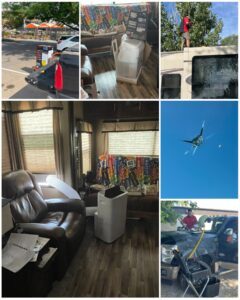 Well, things have not gone perfectly during this leg of my journey. While traveling through the back roads of Montana, I managed to get whacked by a few thrown rocks on the highway, putting a couple of nice chips in my windshield (left, center right). I put a claim in with my insurance, who will cover both chip repair and, as needed, full windshield replacement without having a deductible. So, I made an appointment for my next stop to get the chips filled in so that they don’t crack any further necessitating a windshield replacement. Nik, a Safelite technician (left, bottom right), did a masterful job doing the chip repairs. He even went beyond and did some window detailing on the truck. Thanks Nik! Then, on my second day in Dillon, my primary AC unit in the RV decided to stop working. Of course, it was when we were having a heatwave with temps in the 90s during the day. There was no RV repair within 150 miles of me, nor were there any other civilized retail outlets that could help. So, I decided to drive two hours south to Idaho Falls, ID to a Home Depot to purchase a portable floor AC that I could use until my RV unit gets fixed. The AC I wanted was listed online as having “limited inventory” and required that I go to the store to purchase. No kidding, just as I walked into the store and was heading down the aisle to the appliances section, a guy walking in the opposite direction was pushing a cart with the exact identical AC unit I was there to purchase. As shit luck karma would have it, he got the last one! Had I been there 10 or even 5 minutes sooner, I could have gotten that one myself. I checked the local Lowe’s and they didn’t have anything that would work. So, off I go driving an additional hour further south to the Pocatello, ID Home Depot store, which luckily had ample supply of what I was there to purchase. A three hour drive back home, an hour of getting it unboxed and setup, and once again I had some RV cooling. Never a dull moment when you are on the road! I had a mobile tech come out (left, top right) who got me back running, but a motor replacement or entire AC unit replacement is likely in my future.
Well, things have not gone perfectly during this leg of my journey. While traveling through the back roads of Montana, I managed to get whacked by a few thrown rocks on the highway, putting a couple of nice chips in my windshield (left, center right). I put a claim in with my insurance, who will cover both chip repair and, as needed, full windshield replacement without having a deductible. So, I made an appointment for my next stop to get the chips filled in so that they don’t crack any further necessitating a windshield replacement. Nik, a Safelite technician (left, bottom right), did a masterful job doing the chip repairs. He even went beyond and did some window detailing on the truck. Thanks Nik! Then, on my second day in Dillon, my primary AC unit in the RV decided to stop working. Of course, it was when we were having a heatwave with temps in the 90s during the day. There was no RV repair within 150 miles of me, nor were there any other civilized retail outlets that could help. So, I decided to drive two hours south to Idaho Falls, ID to a Home Depot to purchase a portable floor AC that I could use until my RV unit gets fixed. The AC I wanted was listed online as having “limited inventory” and required that I go to the store to purchase. No kidding, just as I walked into the store and was heading down the aisle to the appliances section, a guy walking in the opposite direction was pushing a cart with the exact identical AC unit I was there to purchase. As shit luck karma would have it, he got the last one! Had I been there 10 or even 5 minutes sooner, I could have gotten that one myself. I checked the local Lowe’s and they didn’t have anything that would work. So, off I go driving an additional hour further south to the Pocatello, ID Home Depot store, which luckily had ample supply of what I was there to purchase. A three hour drive back home, an hour of getting it unboxed and setup, and once again I had some RV cooling. Never a dull moment when you are on the road! I had a mobile tech come out (left, top right) who got me back running, but a motor replacement or entire AC unit replacement is likely in my future.
Final Thoughts
 Well, I’ve wrapped up my time in Montana, and have thoroughly enjoyed it. There sure is lots of open land here, and lots of beautiful mountain ranges. It’s no surprise that Montana is the sixth least populated state in the country. Great place to visit in the summer, but I’m sure I would not in the least enjoy their snowy winter climate. Next I begin my exploration of Idaho. Another state I’ve not been to before, so I’m looking forward to learning what else this state is known for besides potatoes. In between, I’ve enjoyed keeping up with the Paris Summer Olympics, including all the crazy controversies. Geez – I don’t recall there being all these issues in Olympics of the past. It was just all about the sports! I guess we are just at a different time in our lives. Part of me is wishing we go back to those prior, simpler times. Anyway, I saw this meme and thought it would be appropriate for this edition of the blog. Until next time, be well and safe travels!
Well, I’ve wrapped up my time in Montana, and have thoroughly enjoyed it. There sure is lots of open land here, and lots of beautiful mountain ranges. It’s no surprise that Montana is the sixth least populated state in the country. Great place to visit in the summer, but I’m sure I would not in the least enjoy their snowy winter climate. Next I begin my exploration of Idaho. Another state I’ve not been to before, so I’m looking forward to learning what else this state is known for besides potatoes. In between, I’ve enjoyed keeping up with the Paris Summer Olympics, including all the crazy controversies. Geez – I don’t recall there being all these issues in Olympics of the past. It was just all about the sports! I guess we are just at a different time in our lives. Part of me is wishing we go back to those prior, simpler times. Anyway, I saw this meme and thought it would be appropriate for this edition of the blog. Until next time, be well and safe travels!
I only show a sampling of my adventure pictures here in the blog, and do so mostly in collage format for brevity and ease of reading. If you want to view an album containing individual full fidelity and hi-res images of all my travel pictures related to this specific blog, click the image below. Enjoy!

Great blog Bruce!!! You know me too well. I enjoyed (and cried) reading the story of Old Shep. His story is a big part of the reason I love dogs so much. They are loyal and probably the only creatures on earth who love their “best friend” more than themselves. I’ve seen lots of memes on the dog sites I belong to that say” please, if I pass before my dog, let him see my body if at all possible. Dogs understand death and I want him to know I passed and did not leave or abandon him”. I must admit I feel the same. They will wait their entire lives like Old Shep.


 . That road thru Two Medicine was sure scary
. That road thru Two Medicine was sure scary  holy cow. Loved your video. Amazing, beautiful country but like you I wouldn’t want to be there in the winter nor would I want to live in any of those sparsely populated towns or CDP’s. Hard to find goods and services as you found with the AC issues. Not to mention if you had a medical emergency.
holy cow. Loved your video. Amazing, beautiful country but like you I wouldn’t want to be there in the winter nor would I want to live in any of those sparsely populated towns or CDP’s. Hard to find goods and services as you found with the AC issues. Not to mention if you had a medical emergency.
Glacier National Park looks amazing!! Wow
The up and down outhouse gave me a chuckle. I agree I wouldn’t want the bottom if the top was occupied

Safe travels to your next stops!! Hopefully no further maintenance issues. Look forward to the next blog!!
I thought you would enjoy the Shep story. It was a sad one, but truly representative of the devotion shown by these wonderful companions. I look forward to when I slow down my travels so that I too can enjoy the company of one of these wonderful pets. Some day!
While at Glacier, I recommend going across the border into the Canadian Glacier side of the park. We liked it much better than the American side
Hi Scott! I appreciate the recommendation, but alas I was long gone from that area by the time I published the blog. I guess I’ll have to add the Canadian side visit to a future trip. Hope all is well with you and Terry!
Did you see any Amazon trucks in this part of the country? Do they deliver even in those wide open spaces with tiny towns and mile long driveways to ranch homes?
I imagine Amazon does deliver to these rural areas, but I sure didn’t see many trucks around there. Likely they use USPS for the ultimate delivery. Also, I discovered there are not a lot of Amazon Lockers in these small towns. I generally use them when I travel as it’s a convenient way to get things delivered for me to then pickup. But, no such luck in these small towns.
Montana is a great state to visit. I also camped there when I Had my truck camper.I never got to Glacier NP however.
Enjoy Idaho and safe travels.
Yea, I sure did enjoy traveling around the state of Montana. You missed some great scenery by not making it to Glacier. You’ll have to put that on your bucket list.
This was a really good blog. I enjoyed the movie you made of your adventure at Glacier How does that RV park in Browning justify what they are charging, does not look like they have anything to offer. Was the place crowded while you were there? That newest roadside attraction in Polson remined me of the Lochness monster so maybe that is what they are trying to create in their own lake.
Sorry to hear about your A/C issues, but now you have a spare. This summer sure is going by fast, less then 3 weeks before I leave here and head your way. See you soon.
Yea, that campground was pretty sparse. No pool, no camp store, no bathhouse, no laundry, no put put, not even an office. I’d say it was roughly 30-40 percent occupied – certainly not anywhere near full. As for the nightly rates, it’s all about the location. The nearby KOA is charging $125-$145 per night, though they certainly have lots more amenities. I would have stayed there, but I could not secure a reservation as they were booked up. The Polson creature is in fact made to resemble the Lochness – good catch! The summer is definitely going by fast. Just over 8 weeks left for me in this years travels. See ya in a couple weeks in Vegas. Safe travels.
This was a great blog with many interesting places to read about. I waited to look at the pictures on flicker and they were all amazing. Glacier National Park wow what a scenic part of the country. The Montana State prison was cool but I was more impressed with the car Museum. Quite a variety of cars to see and in great condition. My favorite was the Chevy t-bird. Well I hope you get to civilization soon so you can fix your a/c. Enjoy your next eight weeks and looking forward to your return to Florida.
Such a beautiful state!! Love Montana!
Continued safe travels!!